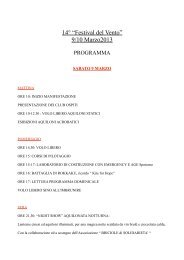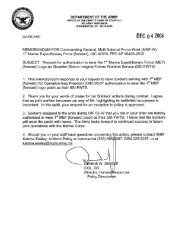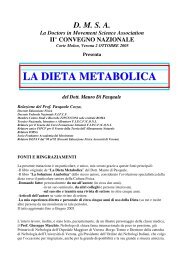Science vs. religion : what scientists really think - File PDF
Science vs. religion : what scientists really think - File PDF
Science vs. religion : what scientists really think - File PDF
You also want an ePaper? Increase the reach of your titles
YUMPU automatically turns print PDFs into web optimized ePapers that Google loves.
188 NOTES TO PAGES 11–19the same respondent. With these labels, I also include the date when the interview wasconducted.Chapter 21. Phys 23, conducted August 13, 2006.2. Chem 38, conducted May 17, 2006.3. The data for the general population comes from the 2006 General Social Survey,the most recent wave of the survey to contain a large number of questions on <strong>religion</strong>.Data for <strong>scientists</strong> was taken from the Religion among Academic Scientists survey(2005). Data from both of the populations has been weighted to allow meaningful analysis.The religious identification categories follow the scheme developed by BrianSteensland and coauthors in their article, “The Measure of American Religion.” Whenwe use statistical tests of significance to compare differences in proportion of adherentsbetween <strong>scientists</strong> and the general population, the comparison is significant at the.05 level.4. Test of significance comparing the percent of atheists and agnostics in the generalpublic compared to their number among <strong>scientists</strong> is significant at the .01 level.5. It is important to point out that I am referring to <strong>scientists</strong>’ perceptions of howthey became atheist, agnostic, or without religious belief rather than directly testingcausality, which is not possible without following <strong>scientists</strong> over time.6. See Budd, Varieties of Unbelief , for a further discussion of atheists and agnosticsin English society from 1850 to 1960. Budd shows that there were a variety of reasonsfor rejecting faith, including reading books that impacted the shift to unbelief, such asThomas Paine’s The Age of Reason , which critiqued institutionalized <strong>religion</strong> andchallenged the inerrancy of the Bible. Budd also mentions that, for those who alreadyhad doubts, the dubious moral actions of a minister were often a final push toward lossof faith. For an alternative view, see Larsen, Crisis of Doubt .7. See Wright, The Evolution of God .8. Merton, The Sociology of <strong>Science</strong> (281) . See Merton as well as Zuckerman, “TheSociology of <strong>Science</strong>.” There is a body of literature in science-and-technology studiesthat criticizes the normative structure of science. See, for example, Hess, <strong>Science</strong> Studies ,and Knorr-Cetina, Epistemic Cultures . Those <strong>scientists</strong> I studied who thought that sciencenecessarily disproves all forms of faith, however, were generally committed to astrict Mertonian definition of science. It is important to note that in the actual practiceof their work, <strong>scientists</strong> do not always perfectly follow the normative structure of science.For this group of <strong>scientists</strong>, when they are comparing science to <strong>religion</strong>, sciencetakes on a more pure, normative structure than it might <strong>really</strong> have.9. PS 13, conducted August 30, 2005.10. Psyc 38, conducted May 24, 2006.11. For more on this topic, see Lakoff, Moral Politics , and Naugle, Worldview .12. Intelligent design (ID) refers to the assertion that “certain features of the universeand of living things are best explained by an intelligent cause, not an undirected process
















